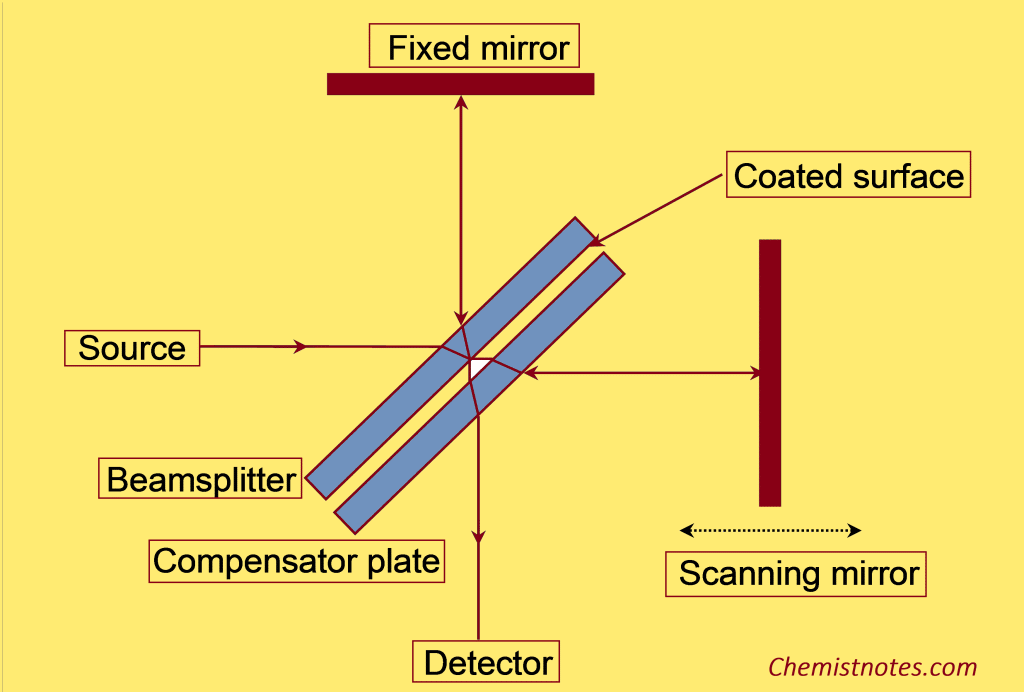Table of Contents
ToggleThe FTIR Spectrometer (Fourier transform infrared spectroscopy) is a modern instrument that is based on a mathematical operation, known as Fourier transformation that converts raw data (an interferogram) into the proper spectrum. It is used to identify organic, inorganic, and polymeric materials by scanning the samples with infrared light. This technique has been widely developed over the last decade and provides a wide range of advantages. The FTIR spectrum is recorded between 4000 and 400 cm-1.
Basic Principle
A beam of radiation with all IR wavelengths is split into two beams, one of fixed length and the other of variable length. An interferogram is produced as a result of the series of constructive and destructive interferences that are caused by the different distances between two path lengths. Depending on the required resolution, the interferogram must be measured from zero path difference to a maximum length. The Fourier transformation helps to convert this interferogram from the time domain to a single spectral point in the more familiar frequency domain.
The smooth and continuous variation of the piston’s length adjusts the position of mirror B and varies the length of beam B. By applying Fourier transformation at various points along this variation, gives rise to the complete IR spectrum.
When this radiation passes through a sample, the compound is subjected to a broad range of energies. Analyzing a single broadbanded radiation pass through the sample results in a complete IR spectrum.
FTIR Instrumentation
A typical FTIR spectrometer includes a source, sample cell, detector, amplifier, A/D converter, and computer. The center of an FTIR spectrometer is the (e.g., Michelson) interferometer. During the measurement, the IR beam enters the interferometer and is directed at a beamsplitter. The beam is then split, and directed at the fixed and moving mirrors, respectively. The beam is recombined (causing interference) and finally directed at the sample material. The spectral information of all wavelengths is acquired simultaneously saving a lot of time.

Components of FTIR spectrometer
1. Infrared Radiation Source
FTIR spectrometers are typically used for mid- and near-IR measurements. Infrared radiation is produced by electrically heating a globar or a Nernst filament to 1000-1800 oF. The Globar is a rod of silicon carbide where as the Nernst filament is a high-resistance element composed mainly of the sintered oxides of Zirconium, cerium, and thorium. Shorter wavelengths of the near-IR require a higher temperature source, typically a tungsten-halogen lamp. The globar is more effective at lower frequencies.
2. Bean splitter
A great beam splitter transmits and reflects 50% of the incident beam. However, because any material has a confined optical transmittance range, several beam splitters can be used interchangeably to cover a wide spectral range. For the mid-IR region, the beamsplitter is typically made of KBr with a semi-reflective germanium-based coating. In a simple Michelson interferometer, one beam passes through the beamsplitter twice but the other only once. An additional compensator plate of equal thickness is used to compensate for this. Far-IR beamsplitters are typically made of polymer films and have a limited wavelength range.

3. Detector
The detector changes the thermal radiant energy into electrical energy. Here, the detectors may be selective or nonselective. Selective detectors are those whose response is markedly dependent upon the wavelength of the incident radiation. Non-selective detectors are those whose response is directly proportional to incident energy but relatively independent of wavelength.
Applications of the FTIR spectrometer
- To characterize the variance in fuel stability of various biodiesel/antioxidant samples, FTIR is used as a novel approach.
- FTIR can be used to identify and characterize unknown materials, detect contaminants in a material, find additives, and detect decomposition and oxidation.
- The absorption peaks in the FTIR spectrum correspond to the frequencies of vibration between the bonds of atoms in the nanoparticle.
- FTIR can be employed for microscopy and image analysis of rubber as well as particle interfacial modifications.
- An FTIR analysis can provide information about the transformation of metallic silver to the Ag0 state.
Advantages of the FTIR Techniques
There are a number of advantages to FTIR methods.
- Because no monochromator is used, the entire radiation range is passed through the sample at the same time and saving a significant time.
- FTIR instruments can have very high resolution.
- IR results are easily manipulated since data undergo analog to digital conversion.
- Due to the use of averaging technique, excellent spectra are obtained, even with a little sample.
- FTIR unit can be combined with HPLC or GC.
- There is also flexibility in the spectral printout; for example, spectra linear in either wavenumber or wavelength can be obtained from the same data set.
FAQs
What does FTIR stand for?
FTIR stand for Fourier transform infrared spectroscopy.
What is FTIR?
The FTIR Spectrometer (Fourier transform infrared spectroscopy) is a mathematical process that converts raw data (an interferogram) into the proper spectrum.






